Denise Sutherland's Blog, page 7
February 6, 2013
Lesson 9: Deletions
Time for the next instalment in this cryptic series – deletions! They can also be called subtractions.
I know you've already figured out what this cryptic device is all about from its name. Yes, we're going to remove letters, and ruthlessly throw them away. Cruel, but fair.
Deletions are used quite a lot in cryptic clues, as it's common to be able to remove a letter or two from one word, to get to another. Some examples :
ABATE - A and E = BAT
CHIP - C = HIP
FREESIA - SIA = FREE
TRIP - T = RIP
And so on.
When it comes to these clues, you not only need to know what word to start with (with deletion indicators), you also need to know which letters to dump (with abbreviations or position indicators). The letter to remove are often clued with a standard (or more cryptic!) abbreviation (such as east = E, street = ST, or 50 = L), but sometimes the clue will tell you to remove the first, middle, or last letters.

Here's a 'pure' deletion clue:
Work the land, without first limb (3)
In this clue, work the land is the word to find a synonym for, and part of the wordplay. Let's try FARM. Now you need to get FARM without its first letter. FARM-F = ARM. And ARM, as you've figured out already, no doubt, is a limb.
However, the deletion device is often combined with other cryptic devices, especially anagrams. Here is an example of just such a 'mixed' deletion clue, where the deletion is combined with an anagram:
Accomplice is sort of loyal, without love (4)
Accomplice is the definition here. Sort of is the anagram indicator. What's the fodder? Loyal, without love. Love is abbreviated to O (looks like a zero, from the tennis score). So we have LOYAL - O = LYAL. Which is an anagram of ALLY! Mad, I know, but it works!
Deletion & Position IndicatorsDeletion indicators are words which tell you to delete some letters. They can be a host of words, anything that gives the sense of removing, excluding, or losing, and so on — such as:
abandonabsentalmostblow offcut short (delete last letter)decapitated (delete first letter)dismissexcludeforgotgoneleaderless (delete first letter)leftlostremovedripped offshorttailless (delete last letter)withoutAs you can see from the example above, the position of the letters to be removed is often included. You might need to indicate the first, middle, or last letters, or the first and last letters, or some other combination.
Some first letter indicators:
at firstbeginningfirstheadlessopeningSome last letter indicators:at lastbackendingfinalelastlySometimes both the first and last letter need to be removed. These have some rather funny indicators:banks (like the banks of a river)borderscasecovers (like a book cover)edgesextremelyfringesoutsiderssidesAnd the middle letters can be indicated with words like:centralgutsinnardsinnerheartstuffingSo if you see lacking guts, lost outsiders, short leader, or lost at first in a clue, or some similar combo, you're looking at a deletion!
There are longer lists of deletion indicators and position indicators on my website.
Practice Deletion Clues
Here are five clues which use deletions to try your hand at. Miss Petal is on the ball, and guarding the clue explanations and answers from the safety of her bag.
1. Yell! Soprano left to get lotion! (5)
2. Rainbow developed without artificial intelligence produces a drab colour (5)
3. Half of cows are feline (3)
4. Tamale without stuffing? What a story! (4)
5. Consumed a clear drink, without the covers on (3)
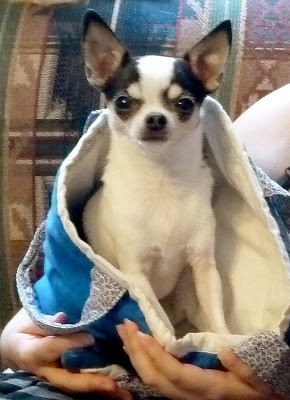 Explanations
Explanations1. A yell is a SCREAM. Soprano leads to the abbreviation S, and left is the deletion indicator. Lotion is the definition, as you've no doubt figured out already. Ignore the punctuation!
2. This clue has a deletion, and an anagram, and an abbreviation — phew! Don't worry, you can do it. Rainbow is the anagram fodder. Developed is the anagram indicator. OK, so we need an anagram of rainbow to get the answer; but the answer is only five letters long, not seven. Without is the deletion indicator. What is rainbow without? The letters AI (keyed by artificial intelligence). So delete AI from RAINBOW, and jumble them up to get the answer. A drab colour is the definition!
3. Feline (as a noun, not an adjective!) is the definition here. Half is the deletion indicator, telling you to just look at half of the letters from another word for cows (let's try CATTLE).
4. This clue has a word 'in the clear' - get that tamale, and try it without stuffing (its middle letters). Story is the definition.
5. Consumed is the definition in this clue. WATER is a clear drink. Without the covers on is the deletion indicator, telling you to remove the covers of the word — in other words, the first and last letters of the word.
Answers1. CREAM
2. BROWN
3. CAT
4. TALE
5. ATE
How did you get on?
Published on February 06, 2013 20:06
January 31, 2013
How to crack cryptograms
Cryptograms are great little puzzles, they pack a lot of punch for their size! This post shows you the basic steps when tackling one of these conundrums. I'm rather partial to cryptograms, and have even written a whole book of the little beasts.
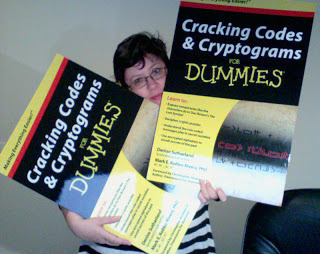 Either I'm extremely tiny, or these book covers are extremely big!
Either I'm extremely tiny, or these book covers are extremely big!A cryptogram is a substitution cipher, which means that each letter of the alphabet has been replaced, or substituted, with another symbol. This symbol can be another letter, a number, or a little icon. (In a code whole words are replaced by a single symbol — such as 'shoot the zombies' is encoded as '16' — and they are very difficult to crack. So don't call cryptograms codes. You'd be wrong, and we can't have that!).
To crack a cryptogram, you need to use letter frequency analysis. Sounds fucking scary, doesn't it? But don't worry, I'll take you through the basic steps in this process below.
Here's the cryptogram for this exercise :
KZV UDFX SODH UT YVPTUUH O KLRYK OY KZV TOYZ YKOES, P KUKPFFX TVPKRLVFVYY TOYZ KZPK HUVYD'K ZPAV VXVCPFFY UL TODY. HPAV CPLLX
Here's what you'll need:A cryptogram or twoA pencilAn eraserSome scrap paperA brainHere's the bare bones list of what to do ... I explain these steps below:
• Look for single letter words• Count the symbols, and find the most common ones• Look for THE and AND• Look for THAT• Look for double letters• Look for apostrophes• Look for 2-letter words
1) Look for Singles
A single letter word will almost always be A or I. Pencil one of these choices in over any single letter word in the cryptogram.
KZV UDFX SODH UT YVPTUUH O KLRYK OY KZV TOYZ YKOES, P KUKPFFX TVPKRLVFVYY TOYZ KZPK HUVYD'K ZPAV VXVCPFFY UL TODY. HPAV CPLLX
In this example, there's two single-letter words, O and P. So O = A or I, and P = I or A!
It's too early to tell which of these two options is most likely, so we need to carry on to the next step, keeping these options in mind ...
Use a pencil to lightly write your guesses above or below each letter in the cryptogram. The best cryptogram books will give you plenty of room for writing above or below the lines of the cipher.
2) Counting Letters
In English text, E is the most common letter, followed by T, A, O, N, R, I, S and H. So it's always helpful to do a tally of all the symbols used in a cipher, and see which ones are the most abundant.
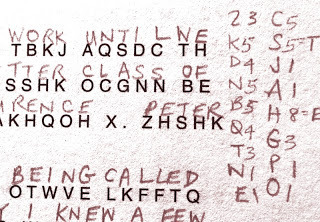 In this example, the most common cipher letter is H
In this example, the most common cipher letter is HIn our cryptogram, the most frequently seen cipher symbols are K, V and Y (11 times each), and P (9 times). So it's a fair bet that these four symbols may decrypt into some of E, T, A, O or N.
Cryptograms generally are short pieces of text; in short texts the standard letter frequencies are often a bit skewed — so E may not be the most common letter, or there may be an unusual number of Fs for some reason, for example.
3) Look for THE and AND
THE and AND are the most common 3-letter words in English.
In our quote, there are two 3-letter words, and they're both the same : KZV
KZV UDFX SODH UT YVPTUUH O KLRYK OY KZV TOYZ YKOES, P KUKPFFX TVPKRLVFVYY TOYZ KZPK HUVYD'K ZPAV VXVCPFFY UL TODY. HPAV CPLLX
So it's pretty safe to guess that KZV either is THE or AND. It's unlikely that a quotation will start with the word AND, so let's give KZV = THE a try.
This also matches with the information we've learnt above, about K, V, Y or P possibly = E (our 'THE' guess would give us V = E) so it's looking good!
Write in your guess letters lightly in pencil above each K, Z and V in the cipher.
It's really easy to miss letters in a cipher, when pencilling in your decrypted letters over the cryptogram — always read through the cipher at least twice, and don't be surprised if you discover you've missed one now and then.
4) Look for THAT
THAT is a special word - it's the most common 4-letter word, and it's a "pattern word". A pattern word is vital when cracking ciphers. It is simply any word which has repeated letters - not necessarily doubles (more on those shortly), but any letter which appears more than once in a word.
THAT has the letter pattern 1-2-3-1. So when you see a 4-letter word that is in this pattern, where the first and last letters are the same, it's a good bet that it's THAT. There are other options, of course (DEAD is another one), but THAT is the most common one.
KZV UDFX SODH UT YVPTUUH O KLRYK OY KZV TOYZ YKOES, P KUKPFFX TVPKRLVFVYY TOYZ KZPK HUVYD'K ZPAV VXVCPFFY UL TODY. HPAV CPLLX
In our cryptogram, we have a word that fits this pattern : KZPK. This fits very well with our theory about KZV = THE. Here's K=T again, in KZPK = THAT.
This also decides for us the "A or I" conundrum from Step 1 - it's clear now that P = A, so that also means O = I.
5) Look for Double Letters
Double letters are very helpful in ciphers. By knowing which ones are most frequently seen in English, you can help narrow down your options.
In this cryptogram, we have a bunch of doubles :
KZV UDFX SODH UT YVPTUUH O KLRYK OY KZV TOYZ YKOES, P KUKPFFX TVPKRLVFVYY TOYZ KZPK HUVYD'K ZPAV VXVCPFFY UL TODY. HPAV CPLLX
The most commonly seen double letters in English are, in order of frequency : LL (most common), EE, SS, OO, TT and RR. There are plenty of others, of course, but they're not seen so often.
We've already figured out that K = T, and V probably = E, so that narrows down our options. So from this information, it's fair to say that U, F, Y and L could = L, S, O or R.
You can also eliminate letters when you have doubles - many letters rarely or never appear as doubles : A, H, I, J, K, Q, U, V, W, X, Y, Z
6) Check your Punctuation
Punctuation is a great help when cracking cryptograms. Keep an eye out for things like questions marks, as the words CAN, WHY, COULD, MAY, and other interrogative terms might appear in that sentence.
Apostrophes are very handy. The letter following an apostrophe can be :
S (IT'S, WHAT'S ...)T (CAN'T, DON'T ...)D (HE'D, SHE'D ...)M (I'M ...)LL (I'LL ..)RE (WE'RE, YOU'RE ...)
In our cryptogram, there's one apostrophe, and it makes sense with our guess about K = T :
KZV UDFX SODH UT YVPTUUH O KLRYK OY KZV TOYZ YKOES, P KUKPFFX TVPKRLVFVYY TOYZ KZPK HUVYD'K ZPAV VXVCPFFY UL TODY. HPAV CPLLX
7) Look for 2-Letter Words
There are a host of commonly used 2-letter words in English : AN, AS, AT, AN, BE, DO, GO, HE, IF, IN, IS, IT, ME, MY, NO, OF, OK, ON, OR, SO, TO, UP, and WE for starters.
Check through the cryptogram for these two lettered combinations. In our cipher, there are several :
KZV UDFX SODH UT YVPTUUH O KLRYK OY KZV TOYZ YKOES, P KUKPFFX TVPKRLVFVYY TOYZ KZPK HUVYD'K ZPAV VXVCPFFY ULTODY. HPAV CPLLX
In any 2-letter word, one of the two letters will be a vowel (unless it's a chemical symbol, an abbreviation, or something tricky like that!).
So we can say that from the cipher words UT, OY and UL, it's likely that two of U, T, O, Y or L are vowels.
8) Putting it all Together
So, let's put all our guesses so far into the cryptogram. I've used lowercase letters for the decrypted message (ignoring punctuation and grammatical conventions for the moment) :
the UDFX SiDH UT YeaTUUH i tLRYt iY the TiYh YtiES, a tUtaFFX TeatRLVFeYY TiYh that HUeYD't haAe eXeCaFFY UL TiDY. HaAe CaLLX
It still looks a bit confusing, but the worst is over! At this point you may be able to make some educated guesses about some of the words. haAe could be HAKE, HALE, HARE, HATE, or HAVE. However, HAVE is the most likely solution, which would give us A = V.
9) More Patterns and Guesses
Now's the time to start making guesses with the remaining letters from your alphabet (we've used up A, E, I, H, T and V). Don't forget, in the text below, the CAPITAL letters are the cipher, and the lower case ones are the 'plain text' (decrypted message).
the UDFX SiDH UT YeaTUUH i tLRYt iY the TiYh YtiES, a tUtaFFX TeatRLVFeYY TiYh that HUeYD't have eXeCaFFY UL TiDY. Have CaLLX
The final two words in the cryptogram, after the full stop, are probably a name (the author of the quote). So Have is probably a first name. Run through the options : Cave, Dave, Fave, Gave, Nave, Pave, Rave, Save, Tave, Wave ... it's fair to guess that the answer is DAVE. So now we have H = D.
the UDFX SiDd UT YeaTUUd i tLRYt iY the TiYh YtiES, a tUtaFFX TeatRLVFeYY TiYh that dUeYD't have eXeCaFFY UL TiDY. dave CaLLX
Let's look at the 2-letter words more seriously now : UT and UL in particular. We've used up most of the vowels, only O, U, and Y are left. No letter is ever encrypted as itself, so we can rule out U = U. Given the letters left over, it's a fair bet that U = O, giving us OF, ON, and OR to choose from for UT and UL. U is also one of the double letters, which works well if it decodes as O.
the oDFX SiDd oT YeaTood i tLRYt iY the TiYh YtiES, a totaFFX TeatRLVFeYY TiYh that doeYD't have eXeCaFFY oL TiDY. dave CaLLX
Now things should start to make sense more quickly - what could YeaTood be? Only one option : SEAFOOD. So Y = S, and T = F - nearly there!
10) All Done
the oDFX SiDd of seafood i tLRst is the fish stiES, a totaFFX featRLeFess fish that doesD't have eXeCaFFs oL fiDs. dave CaLLX
It's practically done! totaFFXis easy to decipher now = TOTALLY (so F = L and X = Y), and doesD't can only be DOESN'T (so D = N).
the only Sind of seafood i tLRst is the fish stiES, a totally featRLeless fish that doesn't have eyeCalls oL fins. dave CaLLy
Sind, tLRst, stiES, featRLeless, eyeCalls, oL, and CaLLy won't tax you for long, I'm sure ...only S, L, R, E and C remain to decrypt. No, I'm not going to write it out here, I know you can figure it out for yourself!
For a whole book of cryptograms and ciphers, with a lot of information on how to solve them, check out Cracking Codes and Cryptograms for Dummies which I wrote with Mark Koltko-Rivera a few years ago. There are also many free cryptograms on the Dummies website, also by yours truly:
Easy Number Substitution CryptogramsCracking Codes & Cryptograms For Dummies Cheat SheetCaesar Ciphers to Amuse — and Confuse — YouUnderstanding the Freemason’s CipherLetter Substitution Cryptograms that May Challenge YouEasy Cryptograms with Letter SubstitutionsDecipher Some Entertaining Symbol Substitution CryptogramsChallenging Letter Substitution Cryptograms to DecipherCryptography 101: Basic Solving Techniques for Substitution CiphersEasy Masonic Ciphers to Figure Out
Published on January 31, 2013 20:48
January 9, 2013
American vs British crosswords
American and British crosswords. Is there a difference?
The short answer is HELL YES!
Now for the long answer ...
There are major differences between American-style and British-style crosswords (which are seen in Commonwealth countries too).
Crosswords were started by Arthur Wynne in 1913, a British man who lived in America, so both countries claim a close connection with the development of this popular puzzle. They developed in slightly different directions in each country, which has led to the varieties we see today.
American-style crosswords are almost exclusively published in America, while British-style crosswords have spread through the Commonwealth — Australia, New Zealand, Canada, South Africa, and other English-speaking nations tend to prefer this variety of the puzzle, as well as the United Kingdom, of course.
A quick look at these grids will show you the most obvious difference between the two varieties :
British-style
Note the pattern of black and white squares. Both puzzles have symmetrical grids, and no two-letter words are allowed.

In the British-style grid above, there are a lot of black squares. Roughly half of the letters in each word are crossed over with another word (what's called "keyed" or "checked" in the industry). This is known as an alternate-letter grid - in general, every otherletter in a word is checked.
American-style
In the American-style grid below, there are relatively few black squares, and every single letter in every word is crossed over by another word. The grid is fully "checked". So it's theoretically possible to solve a whole American crossword by only doing the Down clues, for example.

What different grid designs mean
These two different grid designs lead to major differences in how these two varieties of crosswords are created and solved.
The more open grid structure of the British-style crosswords means that it's much easier for the crossword setter to put a wide range of words into the grid, and they are generally a bit harder to solve, as you get fewer clues for filling in the grid. Both 'quick' definition-type crosswords and cryptic crosswords fall into this design style.
The solid grid design of the American-style crosswords makes life much harder for the crossword setter — having every single letter in every single word crossing over another word is really restrictive. Setters often have to resort to abbreviations, names, unusual and archaic vocabulary, foreign words, brand names, sections of words, and other tricks to fill in the grid. Solving these puzzles can be a bit easier than the British-style ones, as if you're stuck on one word, you can look for the words that cross over it for further hints.
Crafty clues
Just as different grid designs have developed in the two countries, so have different conventions for writing clues.
British-style crosswords come in two varieties :
Quick Crosswords - these are straight definition clues. There aren't any tricks involved or any word play. Different levels of difficulty are created by whether the vocabulary used in the crossword is standard or more obscure, and whether clues are specific or general. General knowledge, archaic words, and common words in other languages are often included.
An example : Bird (4) = TEAL is a difficult clue - there are a lot of birds with 4 letter names! Small duck (4) = TEAL is an easier clue, as you're given more specific information.
Cryptic Crosswords - these fiendish crosswords have the same basis as the British quick crosswords, but that's where the similarity ends! Each clue is a mini-puzzle in its own right. There are a lot of rules and conventions about how these clues are written (see the links in the sidebar for my blog posts about cryptic clues). Each cryptic clue must contain a 'base clue' (synonym for the answer) as well as some word play. This can include double definitions, anagrams, homonyms, charades, puns, amongst many others.
An example : Bird colour (4) = TEAL — as TEAL is both a colour, and a type of bird. This is a double definition clue.
NB : British crosswords tend to have the letter count for the answer in brackets after the clue, but American crosswords don't.
American-style crosswords have a wide variety of clues too. And another major difference with American crosswords is they often have a title and theme. The themed crossword entries are generally some of the longest words in the puzzle, and are placed symmetrically within the grid. Somewhere around three to five words in the crossword will relate to the theme. These theme entries can be words, phrases, or puns, or a whole host of other conundrums. The title for the puzzle usually gives a clue as to the theme.
There are the standard definition clues, as in the Brit's quick crosswords. However, there are also a lot of general knowledge clues, such as the names of actors or authors, movie titles, song names, and other trivia.
Abbreviations are common; these clues are usually indicated with abbreviations included in the wording of the clue. For example : Some sts = AVES ("Some streets are avenues").
Sometimes fragments of phrases, prefixes, suffixes, fragments of words, and foreign words are used. Fill-in-the-blank clues are also fairly common.
A few examples :
From ____ Z = ATO (From A toZ, get it?)
It can be open or safe = HOUSE (Open House or Safe House)
Tour end = IST (Tourist)
So long in Rome = CIAO (an Italian farewell)
There is a wide variety in these sorts of clues; the setter may sometimes also engage in a bit of word play, with pun clues indicated with a question mark.
So as you can see, each crossword variety holds its own challenges, but luckily they are all fun to solve!
(This article originally appeared on the now defunct VideoJug Pages site)
Published on January 09, 2013 16:36
January 5, 2013
Competition #1 Winners!
Wow, guys! What a great selection of cryptic clues you've sent in, I've really enjoyed reading all of them. I hope you've all had fun writing them too, and that you've got a bit of a taste for what cryptic clue writing entails :)
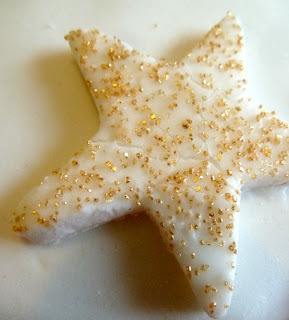
My good friend and colleague Greg Parker (he of Puzzle Wizard fame) and I have discussed all your entries, and have agreed on the following winners:
FIRST
Island weaves its charms (Len)
Christmas Island is the definition here, a really nice lateral take on the word Christmas! And the rest of the clue (weaves as the anagram indicator, and its charms as the fodder) just flows beautifully. Great job, Len.
SECOND
Noel crashed Smith's car (Golem)
Noel is the definition, with a nice bit of ambiguity as to whether Noel is a holiday or a man's name. Crashed is the anagram indicator, and Smith's car is the fodder. Really smooth surface reading.
THIRD
March sits awkwardly as a time to celebrate (Des)
A time to celebrate is the definition. Awkwardly is the anagram indicator, and March sits is the fodder. Another good clean surface reading — good work!
Can you three please email me your postal addresses, and prize preferences (which I will try to take into account, if possible), so I can post out your prizes.
Thank you everyone who entered, you all did well. I will hold more of these clue writing competitions, as they're clearly popular, so stay tuned!
Published on January 05, 2013 18:26
December 21, 2012
15th Birthday Clue Writing Competition!
Today is the 15th birthday of my business, Sutherland Studios. And it's Chrissie time. So to celebrate, I'm giving you pressies — no other course of action else makes sense!
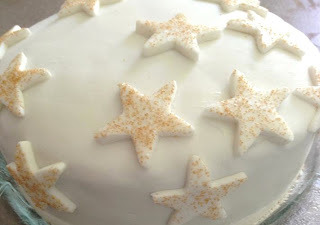
Here's the challenge, should you choose to accept it!
Write a cryptic clue of your very own, using an anagram, for the answer word CHRISTMAS. Write your clue, and an explanation of how it works, in a comment, below this post.
Don't be scared, you can do it. It's even fun (honest)! Your clue can be quirky, surreal, funny, serious, whatever you like. It needs to read well, like a mini phrase or sentence (not just a random assortment of words stuck together). Creativity and clue accuracy are what I'll be looking for.
Here are some tips to help you get started. Your cryptic clue will need:
1) A definition for CHRISTMAS — this can be as simple, as oblique, or as silly as you like. The definition needs to be at the start or end of the clue (not stuck in the middle).
2) An anagram — this needs to be an anagram of the word CHRISTMAS. Something like 'arch mists' — there are heaps of possibilities, and it can run over 2 or 3 words. This is called the anagram fodder.
3) An anagram indicator — this is a word that tells the reader to jumble up the letters of the fodder. This can be a word like cooked, confused, inebriated, or upset. There are thousands of possibilities! Look for a word (or two or three) that matches well, and makes sense, with your fodder.
More help:
You can use this anagram engine or this one to help find some good ways of breaking up the word "Christmas".There is a list of anagram indicators on my website.This post from this blog explains the mechanics of anagram clues.And this post goes into the details of how cryptic clues work in general.
That's it! You've got a fortnight, so entries close at midnight 5 January 2013, Australian Eastern Summer Time (+11 hours GMT).
I will choose my three favourite clues, and winners will be announced on 6 January 2013.
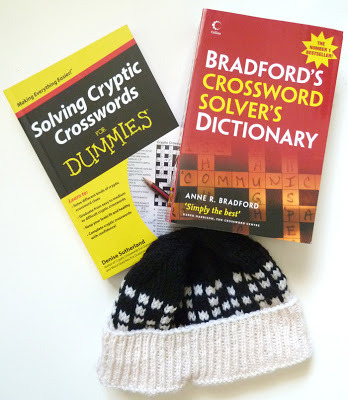
First Prize A signed copy of Solving Cryptic Crosswords For Dummies :D
Second PrizeA copy of Bradford's Crossword Solver's Dictionary, 7th edition, which has heaps of cryptic references, abbreviations, and other useful stuff. Extra good for solving cryptics!
Third PrizeA 1 Across crossword beanie, my original design, knitted by me, as featured on Knitty.com. 100% pure wool. It's the actual beanie featured in the third photo on the Knitty page. Fits an adult.
I look forward to reading your clues!
Published on December 21, 2012 12:23
December 13, 2012
Gemini 6466
 My analysis of the clues from the Gemini Cryptic Crossword from The Canberra Times, Friday 14 December 2012.
My analysis of the clues from the Gemini Cryptic Crossword from The Canberra Times, Friday 14 December 2012.As usual, the definitions are underlined (except in double definition and cryptic definition clues).
Across
1. Son of Susie? (5) = ISSUE
An anagram that doesn't really have an anagram indicator, although it could be argued that the question mark serves that purpose. The anagram fodder is Susie. ISSUE is defined here as progeny/children (hence son).
4. Constitutional nature's changed (7) = SAUNTER
Changed is the anagram indicator, and nature's is the fodder. A constitutional is a rather old-fashioned term for a regular walk (good for the constitution, don'tcha know).
8. Dad's silent partner (3) = MUM
Cute double definition clue. Mum is Dad's partner, but it's also a word that means to be quiet.
9. An order without speech (9) = TRAPPISTS
Cryptic definition. The Trappist monks are an order of monks where speech is not allowed most of the time.
10. Rushed to fire rifle (7) = RANSACK
Charade clue. Rushed = RAN. Fire = SACK (as in "Fire all the staff!"). Rifle is the definition, meaning to rummage through stuff (not a gun).
11. Having no occupation (5) = EMPTY
Cryptic definition, occupation doesn't mean a job here, but the state of being occupied or full.
13. Not put out when one did some hoarding (4,2) = LAID IN
I don't think the definition of this clue is correctly matched to the answer. Surely hoarding should clue LAYING IN, and LAID IN should be clued as hoarded. Cryptic definition? Not sure about this one. I guess the opposite (not) of LAID OUT (put out) is LAID IN?
15. Unions strangely in agreement (6) = UNISON
Anagram clue, indicated by strangely. Unions is the fodder.
18. Ascended a small hill to the north (5) = RISEN
Charade clue. A small hill = RISE + N (North).
19. Thicken stew in cook's place (7) = KITCHEN
An anagram (stew) of thicken.
21. Betrayed — like a bride in church maybe (5,4) = GIVEN AWAY
Double definition. If someone gives you away, you may either be a bride on her wedding day, or a plotter being betrayed!
23. A bishop's responsibility is to make observations (3) = SEE
Double definition: a bishop's responsibility (Dictionary definition: the place in which a cathedral church stands, identified as the seat of authority of a bishop or archbishop) and to make observations.
24. He looks after someone's wardrobe and sideboard (7) = DRESSER
25. Very small driving area close to New York (5) = TEENY
Charade clue - very small is the definition. You can get to it by putting TEE (driving area) next to NY (New York).
Down
1. Dissolute, but I'm getting the message (7) = IMMORAL
Charade clue, IM (I'm) + MORAL (the message, as in the message of a story).
2. I can't mess around with the meanings of words (9) = SEMANTICS
Anagram of I can't mess, indicated by around.
3. Speechless player (5) = EXTRA
Cryptic definition — a player / actor in a movie or play who doesn't say anything is an extra.
4. Is lazy, resulting in a deficiency on board (6) = SLACKS
Container clue. On board = SS (for steamship). A deficiency = LACK. Put LACK inside SS.
5. Numerous men put in place around the East (7) = IMMENSE
Anagram and container. Anagram of men put.
6. Sit up when it is abbreviated (3) = TIS
Cute little reversal - sit written up (backwards) is TIS, an abbreviation of it is.
7. Out of practice but try us anyway (5) = RUSTY
Anagram (anyway) of try us.
12. Assembled the pots as speedily as possible (9) = POSTHASTE
Anagram, indicated by assembled. The fodder is the pots as.
14. Games period (7) = INNINGS
Cryptic definition. Innings are a set period in a game of cricket.
16. Community centre for retired ladies (7) = NUNNERY
Cryptic definition. Retired here means 'retired/retreated from everyday life', not retired from work, so retired ladies can be nuns.
17. A joint stake (6) = SKEWER
Cryptic definition. A skewer is something you might use to stake a roast joint (eg a leg of lamb)?
18. Stiff clothes I'd put on (5) = RIGID
Charade clue - clothes RIG + ID (I'd).
20. Test the patience of a good man at a meeting (5) = TRYST
Charade clue. Test the patience = TRY + a good man = ST (for saint).
22. Contend it's a quarter past six (3) = VIE
Charade clue. Put one of the quarters (of the compass, ie N, S, E, or W) after VI (Roman numeral for six).
Let me know if you have any better thoughts on these clues :)
Published on December 13, 2012 23:27
December 10, 2012
How to judge the difficulty of a sudoku
You know how it goes ... nice shiny new sudoku all alluring in front of you, pencil and eraser at the ready. You start off all happy together, with a great life ahead of you, like this:
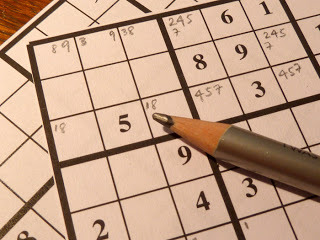
But all too soon the lies start. 'But, but ... you said a seven would go there! What do you mean, you've been seeing another five?' With a horrible inevitability, you end up like this:

What you need is a sudoku of the right difficulty level for you! A bit challenging — keep the relationship fresh and exciting — but without the deceit, long sullen silences, and angry outbursts.
Assessing difficulty levels of sudoku is surprisingly complicated, and can often only be really determined by solving the puzzle, which kinda defeats the purpose. The rankings given in newspapers and book collections of these tricky puzzles are often misleading.
After tech editing a book of sudokus (never again!), I came up with these pointers for assessing how easy or otherwise any given sudoku is.
I hope this list will give you a better idea of whether a particular sudoku is easy, hard, or very hard — but keep in mind they aren't hard and fast rules ... just as in any relationship, there are no standard rules that apply to everyone (well, except the toilet seat rule. That rule applies to everyone.)
The pointers I've included here cover 'standard' 9x9 cell sudokus. It also doesn't matter what the symbols used are - the digits from 1–9, letters, symbols, or whatever.
Counting the givens
Count the number of starting digits (known as givens or clues) in the entire sudoku, before you start to solve the puzzle. How many are there?
Easy sudoku generally have over 32 givens (out of the total of 81 numbers in the answer)Medium sudoku have around 30–32 givensHard sudoku have around 28–30 givensVery Hard sudoku have less than 28 givensDistribution of givens
Look at the distribution of the starting digit, or givens, in the puzzle, within each box (group of 3x3 cells). How many of them have 1 or no givens?
Easy sudoku have more than one given in every boxMedium sudoku may have a couple of boxes with only one givenHard sudoku may have a couple of boxes with only one givenVery Hard sudoku may have several boxes with no givens at all
How many of each?
Next, count how many of each of the digits from 1–9 appear as givens in the sudoku. Don't be shy, these are things you need to talk about with your sudoku, even if it's embarrassing. So shamelessly count how many times 1 appears as a given, then how many times 2 appears, and so on up to 9.
In Easy sudoku, each digit from 1–9 appears as a given at least 3 timesIn Medium sudoku, some digits may only appear twice as a given, the rest will appear at least 3 times eachIn Hard sudoku, three or four digits may only appear 2 times as givens, and one digit may only appear onceIn Very Hard sudoku, most digits appear only 2 or 3 times, as well as several single occurrences
So, using the information you've gathered from the steps above, you can get a clearer idea of how fucking impossible tricky that deceptive little puzzle in front of you really is. Ask yourself honestly: is this a relationship that will drive you mad?
The final definitive bits of information can only be gathered by actually doing the puzzle (during the post mortem).
Make a note of how long it takes you to solve the puzzle, and whether you needed to make any guesses, using trial and error, along the way.
Easy sudoku are very quick to solve, under 10 minutes on average, and no guesses are required.Medium sudoku take a bit longer to solve, somewhere between 10–20 minutes. No guesses are required.Hard sudoku may take up to 45 minutes to solve, and some trial and error may be needed (for example, one box may have two candidates, and no way of determining which digit to use apart from picking one, and seeing whether it works or not).Very hard sudoku can take over an hour to solve, and require trial and error.I hope these pointers help you to better understand the sudoku in your life, and have positive supportive relationships with them. Invite me to the wedding.
Published on December 10, 2012 16:06
November 26, 2012
Crosswords for my foodie friends
At last, there's a crossword app just for us foodies! My new Gourmet Crosswords app has just been launched, for all iOS devices (apart from very old devices, as Apple no longer supports them in new apps, unfortunately).
There are 25 crosswords, all 15 x 15 grids, for only 99¢. As with our QuickBreak apps, the crosswords are completely customisable: you can change the backgrounds, grid colours, letter colours, highlight colours, and choose between five different fonts. We've added a nice new script fancy font.
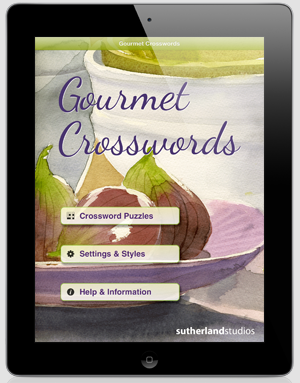
The graphics feature one of my watercolours, a still life with figs.

So — just how good a gourmand are you? Test out your knowledge of cooking techniques, international recipes, ingredients, wines, and spirits on the Gourmet Crosswords to find out! Can you score 100%?!

Published on November 26, 2012 20:26
November 20, 2012
Gemini 6441
It's been a while, sorry! Anyway, here is the analysis of the Gemini Cryptic from The Canberra Times, Monday 19 November.
The definition is underlined, except in double definition and cryptic definition clues.
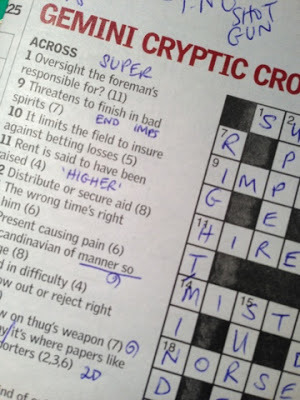 ACROSS
ACROSS1) Oversight the foreman's responsible for? (11) = SUPERVISION
Cryptic definition. 'Over sight' is sort of a coined definition for 'super vision'. What the foreman is responsible for is the definition.
9) Threatens to finish in bad spirits (7) = IMPENDS
Container. Finish = END. Put it in IMPS (bad spirits). IMP(END)S.
10) It limits the field to insure against betting losses (5) = HEDGE
Double definition. A HEDGE can limit the field (as in bordering a garden or field), and a HEDGE fund is one that insures against betting losses (speculation losses, rather than race track betting losses).
11) Rent is said to have been raised (4) = HIRE
Homophone, indicated by is said. As is common with homophone clues, it's not very clear which word of the homophone pair is the definition and which one's the wordplay. The letter count count helps here ... Rent is HIRE, and to have been raised is HIGHER. HIRE is the only one with 4 letters, which will fit in the grid.
12) Distribute or secure aid (8) = RESOURCE
Poor double definition clue. It's best if the two meanings used for the one word in a double definition clue have more 'separation' in meaning ... not so here. Distribute is the first definition, and secure aid is the second one.
14) The wrong time's right for him (6) = MISTER
Anagram clue, indicated by wrong. The letter to be jumbled up (the fodder) are time's (ignore that apostrophe) and R (abbreviation of right).
16) Present causing pain (6) = TENDER
Double definition. TENDER meaning to formally offer or present something, and causing pain.
18) Scandinavian of manner so strange (8) = NORSEMAN
Anagram clue. Manner so is the fodder, and strange is the anagram indicator.
19) Bird in difficulty (4) = KNOT
A tricky one for us Aussies! Double definition - a knot is a British wading bird, as well a term for a difficulty.
22) Throw out or reject right away (5) = EJECT
Subtraction / deletion clue. Take reject, and take R (abbreviation of right) away! R-EJECT.
23) Review on thug's weapon (7) = SHOTGUN
Anagram clue, indicated by review. On thug's is the fodder, and they certainly do create a weapon when muddled up!
24) Anyway it's where papers like to have reporters (2,3,6) = AT ALL EVENTS
Nice double definition clue. Anyway is the first definition, and it's where papers like to have reporters is the second one.
DOWN
2) Superior kind of cut (5) = UPPER
Double definition. Superior is the first definition, and a kind of cut (UPPERcut) is the second. What a blow!
3) A girl from Aden (4) = EDNA
Unfair anagram clue. I always think that clueing any name as a girl (or a boy) is rather unfair on the solver. So the definition in this clue is a girl. Which means that any 4 letter girl's name could be the answer. Yeah. There's a lot of them. Anyway, on to the rest of the clue. From Aden is the wordplay. It's an anagram of Aden, but there is no anagram indicator, which is also unfair.
4) Container ship (6) = VESSEL
Double definition. I bet you can figure out which are the two definitions, seeing as there are only two words in the clue!
5) Vessel sunk at the bar (8) = SCHOONER
Oooh cheeky ... using vessel in this clue, directly beneath the clue where VESSEL was the answer! Double definition clue. A SCHOONER is a vessel (sailing ship). And it's also a type of glass for alcohol, served and maybe drunk (or sunk) at the bar!
6) Regulated as instructed (7) = ORDERED
YADD! Yet Another Double Definition. Something that is regulated can also be said to be ORDERED. And if you were instructed to do something, you may have been ORDERED to do it.
7) Just a privilege objected to (5-6) = RIGHT-MINDED
Charade, not a frightfully good one. Just, as in fair, is the definition. A privilege = RIGHT, and objected to = MINDED.
8) Discerning writer and French sailor (11) = PENETRATING
Charade clue. A writer is a PEN. Add on and in French (ET), and then another word for sailor (RATING - a British term for a non-commissioned sailor in the navy). Discerning is the definition.
13) It gives the sculptor's work some standing (8) = PEDESTAL
Cryptic definition. A sculpture can definitely stand on a pedestal!
15) Fit and sure maybe but altogether too much (7) = SURFEIT
YAA! Yet Another Anagram! Maybe is the anagram indicator, and the letters to jumble up are fit and sure. An anagram of FITSURE is SURFEIT!
17) Lashes out in a quarrel (6) = HASSLE
Anagram, indicated by out. Lashes is the fodder. I wasn't sure about quarrel as a definition for HASSLE, but my Oxford Dictionary tells me that HASSLE can mean a disagreement or quarrel in the USA, so fair enough.
20) Dark disturbing thing (5) = NIGHT
Final anagram clue, indicated by disturbing. Thing is the fodder, and dark is the definition.
21) He does keep talking well (4) = BORE
The tenth double definition clue in this crossword — what a lot! He does keep talking is the first definition, and well is the second one (as in a well in the ground!).
How did you get on?
Published on November 20, 2012 17:19
November 7, 2012
Fuck yeah - Quick Break 2!
Because I've written so damn MANY crosswords over the last few years, we've already got Volume 2 of our Quick Break app up and running!
So - same awesome interface - 50 new crosswords - with a supercool red look, instead of purple. As with Quick Break 1, you can customise the interface in roughly a trillion ways.
Check it out! It's shiny!
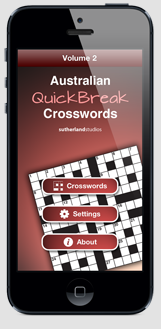
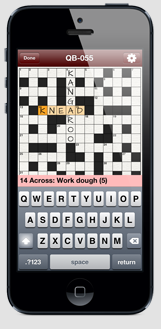
Published on November 07, 2012 13:50



